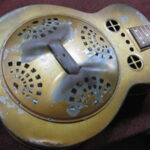Dealing with a cloudy finish on your guitar can be frustrating. This issue, often described as a milky or hazy appearance in the guitar’s finish, is a common concern for guitar owners. If you’re noticing a “Guitar With Cloudy Finish”, understanding the cause and potential remedies is key.
The primary culprit behind a cloudy finish is usually trapped moisture within the lacquer. This is particularly prevalent in guitars manufactured in humid environments or those that have experienced significant temperature or humidity fluctuations. As mentioned in guitar forums, brands like Washburn, Takamine, and Yamaha, along with some US-made guitars such as Guild and Gallagher, can be susceptible to this issue.
Determining the type of finish is crucial for considering any fixes. If your guitar has a nitrocellulose lacquer finish, there’s a potential, albeit risky, remedy. Some luthiers suggest carefully applying a mixture of lacquer thinner and retarder. This approach aims to allow the trapped moisture to escape. However, it’s a delicate process best left to experienced professionals as improper application can further damage the finish. For guitars with polyester or polyurethane finishes, unfortunately, there’s generally no effective repair. These finishes are less porous, making it nearly impossible to remove trapped moisture without a complete refinish.
A quick diagnostic test involves wiping the cloudy area with water or alcohol. If the cloudiness temporarily disappears and returns as the liquid evaporates, it suggests the issue might be on the surface or within the finish itself, offering a sliver of hope for repair in nitro finishes. However, if the cloudiness persists regardless of surface treatments, the problem is likely deeper within the finish layers or even between the finish and the wood.
While a cloudy finish is often a cosmetic issue and doesn’t impact the guitar’s structural integrity or playability, it can be visually unappealing. Factors like prolonged exposure to UV rays, such as leaving a guitar in direct sunlight, might exacerbate finish problems over time. Ultimately, if the cloudiness is on the back or in an inconspicuous area, and especially if the guitar is still playable and enjoyable, many players choose to accept the imperfection rather than pursue costly or potentially damaging repairs.

